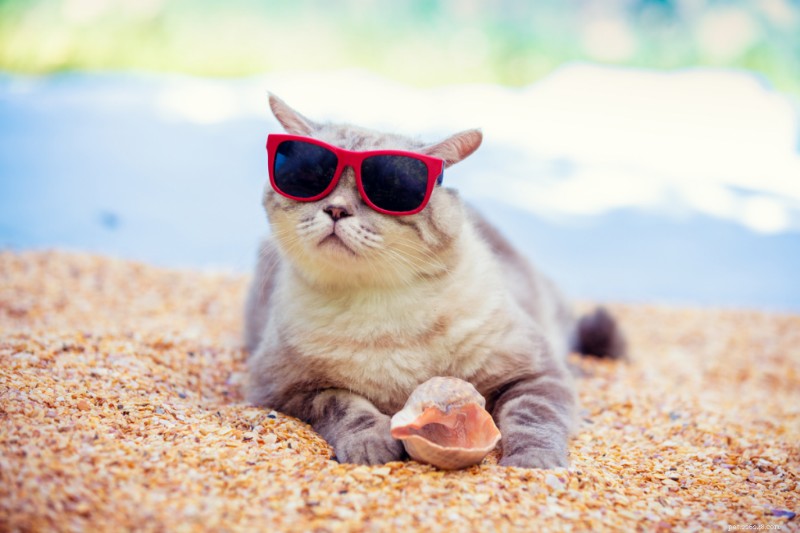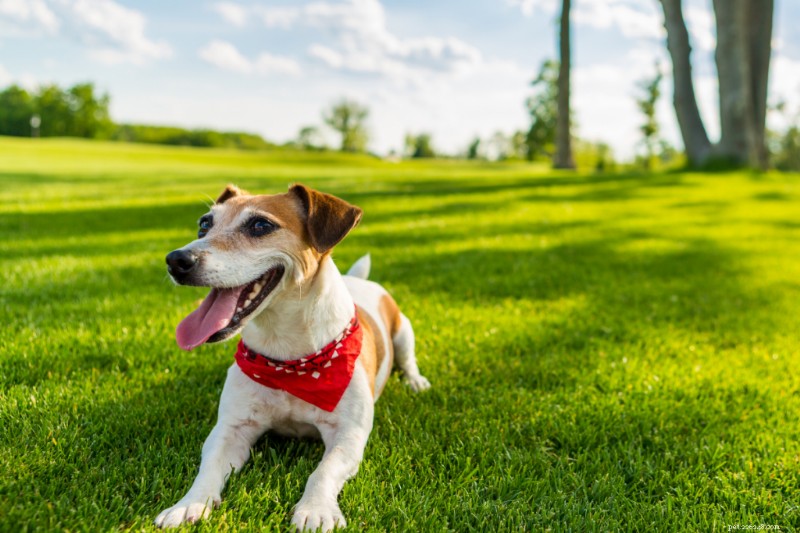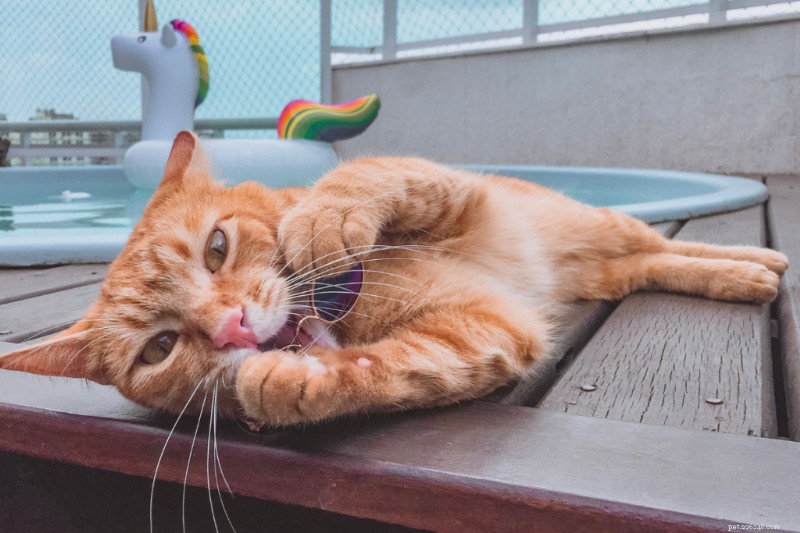Ouders van gezelschapsdieren weten dat het tijdens de hitte van de zomermaanden van cruciaal belang is om op uw huisdieren te letten. De hete, plakkerige temperaturen die optreden tijdens de 'Hondendagen van de zomer' brengen ook een verhoogd risico op hitte-uitputting en zonnesteek met zich mee, dus het is essentieel om de veiligheid van huisdieren in de zomer te benadrukken.
Honden kunnen zichzelf alleen koelen door te hijgen, wat betekent dat ze voor een ventilator niet hetzelfde verkoelende effect op hen hebben als op jou. Katten kunnen voor een mensachtig zweeteffect zorgen door hun vacht te likken, maar een koele, schaduwrijke kamer of kamer met airconditioning is de beste optie om uw huisdieren veilig en gelukkig te houden.
Als je op zoek bent naar een oplossing om het meeste uit de zomer te halen en tegelijkertijd van de veiligheid van huisdieren een topprioriteit te maken, bekijk dan deze tips voor de veiligheid van huisdieren voor de zomer.

Als u van plan bent om uit te gaan en boodschappen te doen, laat uw huisdier dan veilig thuis. Tijdens de zomermaanden warmt uw auto snel op tot ondraaglijke temperaturen, zelfs met een gebarsten raam. Dit kan leiden tot ernstige gezondheidscomplicaties, waaronder bewustzijnsverlies, orgaanfalen, zwelling van de hersenen en overlijden. Zelfs als het buiten 'koel' aanvoelt, zijn de temperaturen in uw voertuig nog steeds onveilig.
Voor degenen die wel van plan zijn om tijdens de zomermaanden met een huisdier te reizen, moet u een plan hebben om uw huisdier te beschermen als u onderweg naar het toilet moet.
Als u met iemand anders reist, gaat u om de beurt naar binnen terwijl één persoon in het voertuig blijft terwijl de airconditioning voor uw huisdier aanstaat.
Als je alleen bent, moet je een manier vinden om je huisdier mee te nemen. Een optie is om te stoppen bij dierenwinkels en diervriendelijke winkels. Een andere mogelijkheid is om een reismand voor huisdieren of een kinderwagen aan te hebben om uw huisdier naar de haltes langs de weg te brengen.
Als je een huisdier tegenkomt in een hete auto, zijn er enkele legale manieren waarop je kunt helpen.
Naast de gevaren van hete auto's, bestaat er ook het risico dat iemand in uw auto inbreekt en uw huisdier steelt terwijl hij of zij onbeheerd wordt achtergelaten.
Hoe verleidelijk het ook is om uw hond of kat mee te nemen naar uw plaatselijke zomerfestivals en evenementen, de beste keuze die u kunt maken voor de veiligheid van uw huisdier is om ze thuis te laten. Tussen de geluiden, de onbekende geuren, de drukte en de hete stoep of trottoirs, doet u uw huisdier meer kwaad dan goed door ze mee te nemen.
Als je je huisdier wilt laten zien aan je vrienden, blijf dan bij de smartphone vol met huisdierfoto's die de meeste ouders van huisdieren bij de hand hebben.
Als u tijd buitenshuis met uw huisdier doorbrengt, overweeg dan om zonnebrandcrème aan te schaffen om ze te beschermen tegen de gevaarlijke UV-stralen van de zon. Lichtgekleurde honden en katten of mensen met ongelooflijk korte vachten zijn vatbaar voor zonnebrand, net als hun mensen. Ze lopen ook het risico huidkanker te krijgen als u geen voorzorgsmaatregelen neemt om ze te beschermen.
Vraag uw dierenarts om advies over huisdierveilige, niet-giftige zonnebrandmiddelen.

In addition to using sunscreen, you can protect your pet from the sun by finding shade as often as possible. When on walks, switch to the shady side of the sidewalk.
If you are going to be spending time outdoors somewhere where there is no shade readily available, consider bringing along a beach umbrella, tent, awning, or sun shelter to create your own shade.
Do you have a high-energy dog or cat that enjoys playing outdoors? If you know that your dog will chase a ball or a frisbee until they drop or you cat will walk or hike for hours, this is a tip that you should consider!
Dehydration and heatstroke are real possibilities during a hot, humid summer day, even in the safety of your own backyard. Limit the high-energy activities to the cooler morning or evening hours. Pets that are brachycephalic, those with flat-shaped faces such as Pugs, Pekingese, or Persian cats, have a harder time cooling themselves by panting. Additional precautions need to be taken to keep these breeds cool in the hot summer months.
Make sure that your pet’s water dish is always full of water. Don’t let it get to the point where the dish is empty and you fill it, leading to your pet overindulging. This can lead to bloat and an emergency trip to see the vet. Warning signs of dehydration in pets include dry and pale gums, excessive drooling, loss of skin elasticity, and acting lethargic.
If you take your pet for a walk, visit the beach, or head out on the hiking trails, make sure you bring a bowl and fresh water. Make frequent stops to give your pet a sip or two, preventing them from drinking too much at any one time.
During the warmer months, you may find yourself out and enjoying the beautiful weather by taking more walks. Use caution when you’re walking your pet in unfamiliar territory. There are some communities that still use non-pet-friendly pesticides and many of those chemicals have a sweet flavor that is enticing to your pet.
If your pet walks in pesticide-treated grass then licks their fur or feet, they could be ingesting poisons. It’s always best to know where you’re walking your pet before you set out and keep an eye out for small lawn flags signaling pesticide application during your journey.
Another point to consider when planning your walks is the time that you are heading out. During the summer months, surfaces such as pavement, cement, and asphalt can become dangerously hot. These surfaces absorb and retain the summer heat, causing the temperatures to rise far beyond that of the surrounding air. Walking on these hot surfaces could lead to heat blisters and burns on your pet’s delicate paw pads. Instead, plan your walks for the early mornings and cooler evenings.
If you do need to head out with your pet during the warmer hours of the day, take precautions to protect their paws. If possible, carry your pet when navigating hot surfaces. Another option would be to outfit your pet with breathable, summer-friendly paw booties.

If you have a dog or cat with long fur or a double coat, you may be worried that all the extra fur is going to leave them feeling overheated. Even though it may be tempting, you shouldn’t give in to the urge to shave your pet’s long fur off for the summer. Your pet’s hair acts as a protective layer.
Instead, brush them regularly to remove excess fur from their natural seasonal shedding and focus on giving them access to a cool space to relax.
During the summer months, your pets may encounter unwanted parasites while they are out and about. To keep your pet safe from unwanted hitchhikers, you should consider using the appropriate preventative medications. Contact your vet to discuss the available options and which would be best for your pet’s needs.
Even with the necessary preventatives, your pet may encounter a tick. To reduce your pet’s chances of dealing with complications such as Lyme disease, take the time to do a full check of your pet’s body for ticks after spending time outdoors. Focus largely on the vulnerable areas including the head, ears, eyelids, under the collar, between the toes, groin, armpits, and tail. Learn how to remove a tick safely and consider carrying a tick key with you.
What do you do to keep your pets cool, happy, and healthy during the summer months? Feel free to share your summer pet safety tips in the comments!